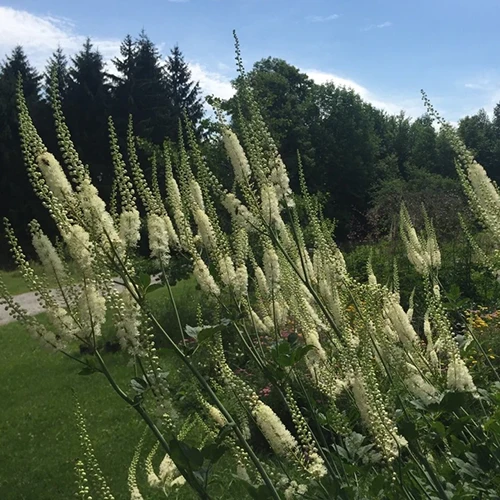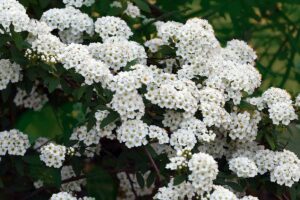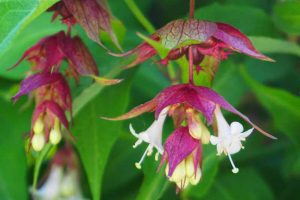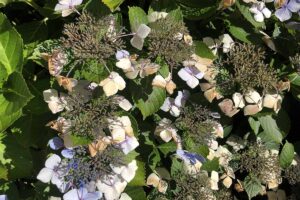Actaea spp.
Its berries might be toxic, but its beauty is anything but.
Baneberry is a plant in the buttercup family, Ranunculaceae, that’s worthy of a spot in your woodland garden.
The common name for many species of plants in the Actaea genus, this plant is aptly named. “Bane,” of course, is a word that means deadly. It is closely related to wolfsbane and monkshood, two other toxic plants.
This bush is often found growing in the wild, preferring to root itself in heavily wooded areas that contain moist, nutrient-rich soil.
Hardy in Zones 3 through 8, this plant can be found in a variety of ecosystems, including coniferous, deciduous, and mixed forests, in swamps, and along the banks of streams and rivers.

We link to vendors to help you find relevant products. If you buy from one of our links, we may earn a commission.
Since this shrub grows wild in so many different locations, it probably won’t surprise you that it’s also exceptionally easy to grow in backyard gardens.
With gorgeous fragrant flowers that attract all kinds of pollinators, native baneberry can make a lovely addition to a shady border or a woodland planting.
It’s a low-maintenance option that’s prized for its ornamental fruits, and showy foliage.
Ready to learn more? Here’s what we’ll cover:
What You’ll Learn
What Is Baneberry?
Baneberry is the common name for a variety of species of plants in the Actaea genus. There are more than two dozen species in the genus, including many that are commonly referred to as cohosh or bugbane as well.
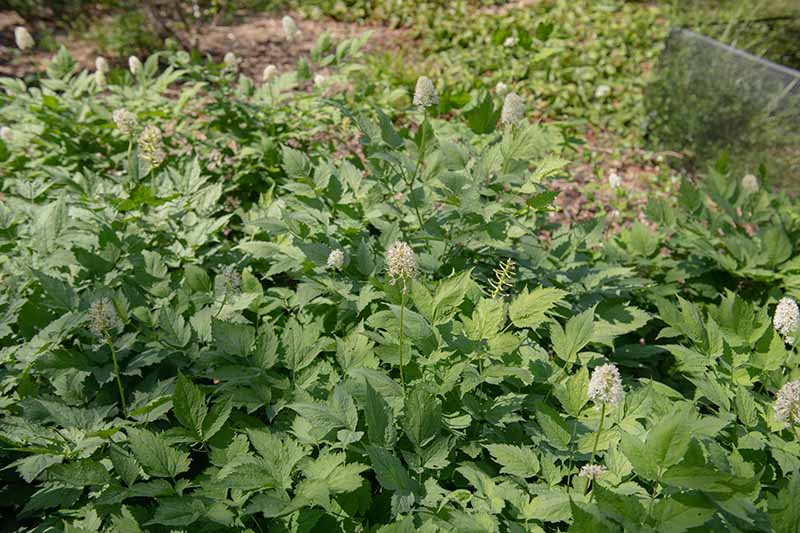
Baneberry is a perennial deciduous shrub that matures to a height and width of one to three feet.
It produces multiple branched stems and gorgeous white flowers that typically appear starting in May. It is slow-growing, and does not spread aggressively in the garden.
The plants are dioecious, meaning some plants produce male flowers and others produce female flowers.
Although the flowers only remain in bloom for a month or two, the plant offers additional ornamental appeal throughout the year with its large green leaves, and red or white berries.
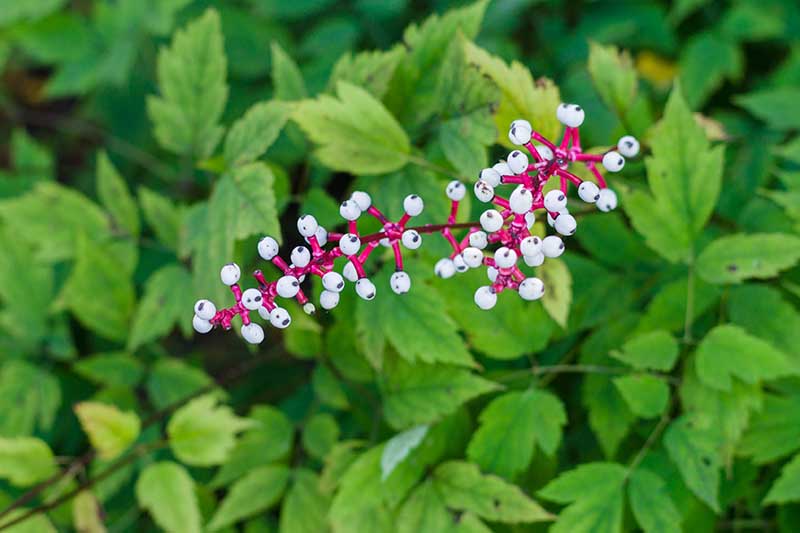
These berries are perhaps the most notable feature of the plant.
Present only when flowers have been pollinated successfully, these waxy berries start out green but ripen by late summer and hang on until the first frost.
A Note of Caution:
The color of the berries varies depending on the species, but all are toxic.
All parts of the plant contain the glycoside ranunculin, which is converted into the toxin known as protoanemonin when chewed or crushed. Ranunculin is found in the highest concentrations in the roots and berries.
If ingested, protoanemonin can have an immediate effect on both the digestive and cardiovascular systems of humans, pets, and livestock. It can also cause skin irritation, so be sure to wear gloves when pruning or working with this plant.
Be sure to keep an eye on any youngsters or curious pets who may like to experiment with putting berries and leaves in their mouths.
It’s the perfect addition to the shady woodland or border garden and provides interest well into the fall, after which point the leaves change color to yellow or light red, then die back and fall off for the winter months.
Cultivation and History
Baneberry is found in moist forests and grows well in cool, nutrient-rich locations. It is often found growing alongside trees like birch, Douglas fir, Engelmann spruce, and other species that prefer these moist, cool environments.
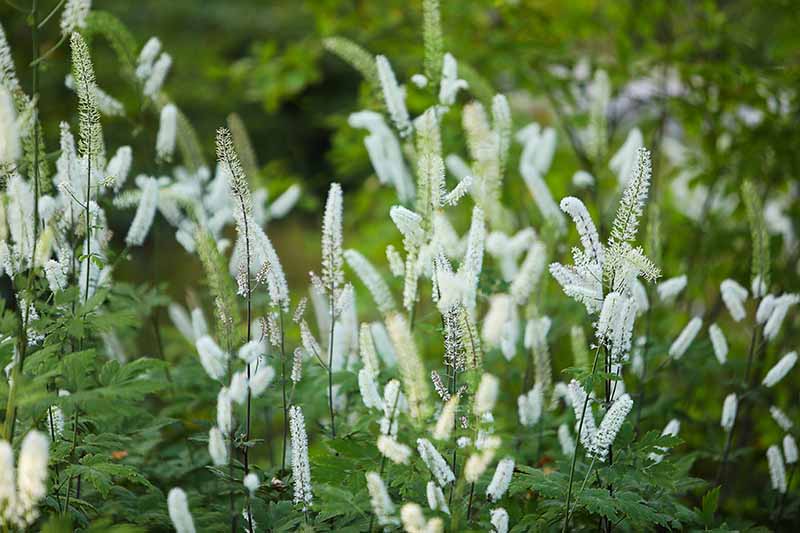
Although its berries are poisonous, causing symptoms such as stomach cramps, vomiting, headaches, and diarrhea if ingested, it was once used by Native American tribes, notably the Ojibwa and the Potawatomi, as a common medical treatment.
When diluted in a weak decoction, the roots were used to relieve cold-like symptoms, and the leaves were mashed up and used as a wound treatment.
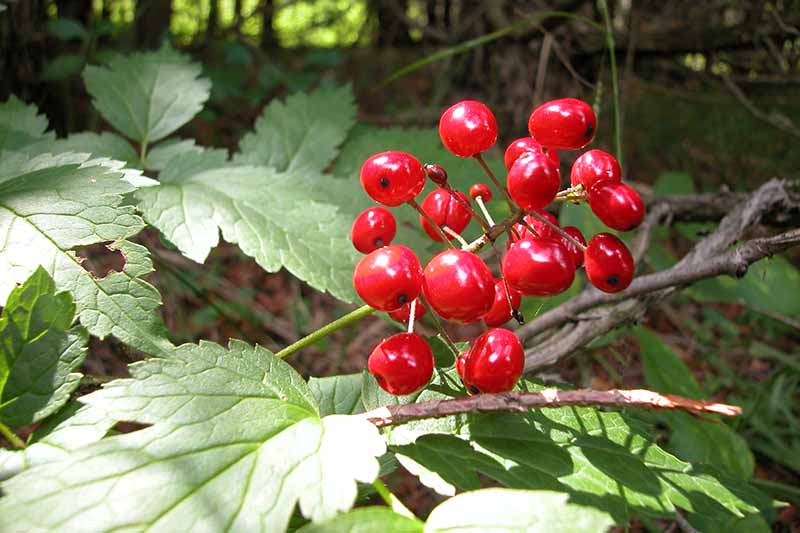
Besides being found growing naturally in the wild, baneberry is often planted in woodland gardens.
Because it tolerates deep shade and damp soils with ease, it’s a good choice for gardeners who may not have many other options when it comes to selecting woody shrubs.
Depending on the type, you may also hear it referred to as cohosh, necklace weed, snakeberry, or bugbane.
A. pachypoda, aka white baneberry, is commonly known as doll’s-eyes as the sinister-looking berries are white with a black spot.
Red baneberry (A. rubra) features bright red berries, and was first catalogued and cultivated as an ornamental plant in 1907 by Eloise Butler in Cokato, Minnesota. It was originally described and named by Scottish botanist William Aiton in 1789.
Propagation
Baneberries are easy to grow from seed. You can do so by purchasing seeds or collecting the berries from plants you already have.
From Seed
The most common method of growing baneberry is to sow seed collected from the berries.
Remember that the berries are highly toxic and you will need to wear gloves and handle them with care to prevent contact with your skin or accidental ingestion.
Plant seeds once, and you probably won’t have to do it again if you want more plants, since this plant self-seeds readily. You can remove these new volunteer plants and transplant them wherever you’d like.
Each berry contains fewer than 10 seeds, which typically germinate two years after they have been sown. Plants will bloom the following year after germination.
You can pick ripe berries and plant them immediately into the ground.
To do this, remove the flesh and sow the bare seeds half an inch deep, two to three feet apart in the fall. They require two periods of cold stratification for successful germination, which will happen naturally outdoors over the winter months.
You can also start your seeds indoors. To speed up germination, an article by the California Native Plant Society recommends that you provide them with alternate cold and warm treatments over the course of a few months.
Here’s how to do it:
Put the seeds in a container of moist seed starting mix, then seal the container in plastic to lock in the humidity. Place the container in the refrigerator or another location that maintains a temperature of 35 to 40°F for two months.
Remove the container from the cold location and place it in a warm location that maintains an even temperature of 70 to 75°F for six to eight weeks. Then move it back into the cold location for a further two months.
Sow the seeds half an inch deep in moist seed starting mix. Keep the soil moist until your seeds germinate. As long as you have taken care to provide the seeds with alternating periods of exposure to cold and warm conditions as described, they should germinate within two or three weeks.
Once germination occurs, place them in a location where they will receive filtered sunshine, but out of direct light. Keep the soil evenly moist.
When you transplant in the spring, keep in mind that the plants will not typically produce flowers until the second growing season.
Before planting out, be sure to harden off your seedlings by placing them outside in a protected location for increasing amounts of time each day over the course of a week to 10 days.
To transplant, dig a hole that is twice as deep and wide as the root ball. Gently loosen the roots of each plant and insert it into a hole. Backfill with soil, tamp down and then water deeply.
By Division
Mature shrubs can also be dug up and divided in early spring. In addition to providing new plants for transplanting elsewhere in the garden, division may help to rejuvenate existing shrubs.
You can learn more about how to divide perennials in our guide.
How to Grow Baneberry Bushes
This shrub thrives in fertile, moist soil that is rich in organic matter. While it can tolerate full shade, a bit of sun exposure can help the plant to produce more beautiful blooms.
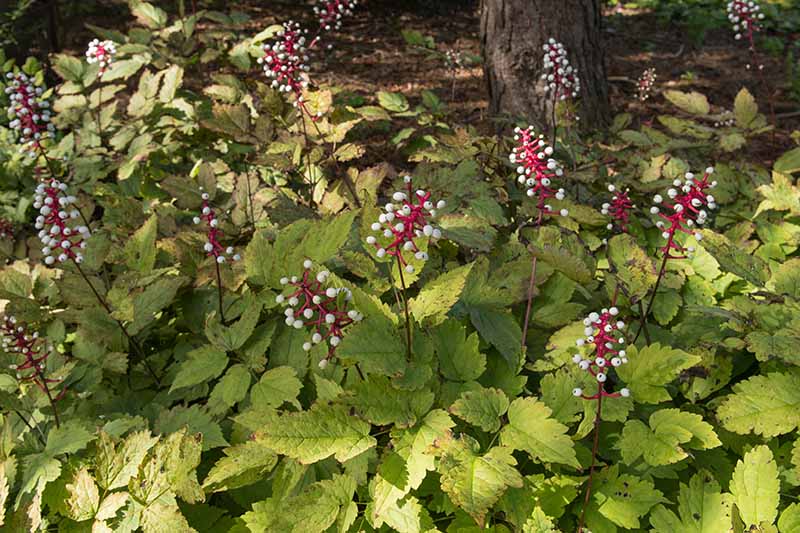
Although you shouldn’t allow the soil to dry out completely, good drainage is necessary to help prevent soggy conditions.
Baneberry can tolerate the occasional deluge and can even thrive under shallow, dense-rooted trees like maples, but even soil moisture is preferred.
Tolerant of most soil types as long as it has even moisture, a slightly acidic pH of 5.6 to 6.5 is preferred. Its native range extends from Canada all the way to Georgia, so baneberry can tolerate a variety of climates. Avoid planting in overly saline soil.
To help build organic matter around your shrubs, let fallen leaves build up around the plants and act as a mulch.
Alternatively, you can use another type of organic mulch such as wood chips or straw to help conserve soil moisture and keep it cool.
Water regularly during the growing season in the absence of rain, to keep the soil evenly moist but not waterlogged.
If you notice that your plant’s leaves become dull in color or begin to drop prematurely, this can be a sign of a lack of water, or of oversaturation.
As long as you take care to plant your baneberry in fertile soil, you should not need to apply fertilizer. An application of compost in the spring can help to replenish nutrients in the soil.
Growing Tips
- Cold stratify seeds to promote germination.
- Plant in well-draining, rich soil.
- Mulch at the end of fall to protect roots for winter.
Pruning and Maintenance
Very little maintenance is required to care for this easygoing shrub.
You can cut the plant back to the ground in the late autumn to tidy up the garden, but this is not necessary and won’t do much to improve the health or growth of the plant.
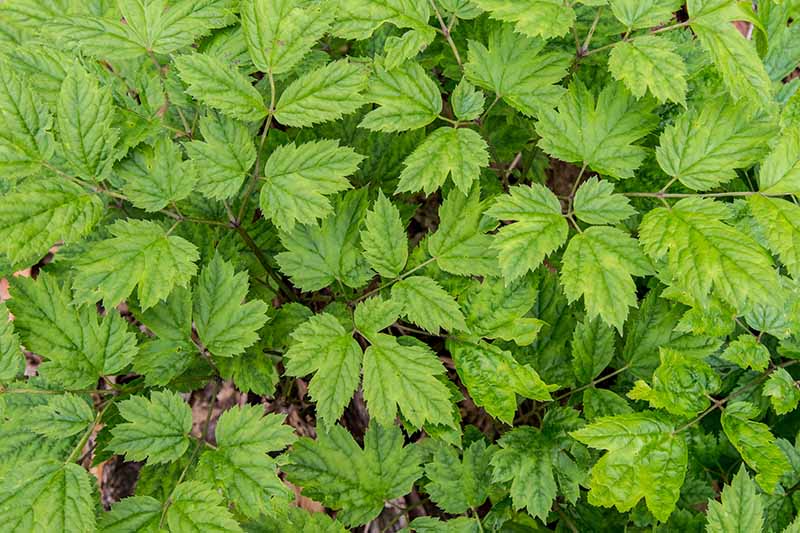
There is also very little you need to do to help the plant over the winter. You will notice the green stems of the plants darken to red towards the end of summer, and the berries will hang on until the first frost.
The plant will go dormant in the fall, but rest assured that its roots will remain strong underground to help it regrow the following year.
Mulching at a depth of one or two inches helps to protect the roots from frost during the winter season.
Species and Cultivars to Select
There are several types of baneberry that you might want to consider growing in your woodland garden.
White baneberry, A. pachypoda, is a popular ornamental species that reaches two feet tall at maturity.

Also known as doll’s eyes, it has small white flowers that appear in clusters, and produces white berries with purple spots that look much like the eyes of a doll.
There is only one hybrid cultivar of this species available – ‘Misty Blue.’ It features blue-green foliage that remains vibrant from spring through fall.
Red baneberry (A. rubra) is nearly identical to white baneberry.
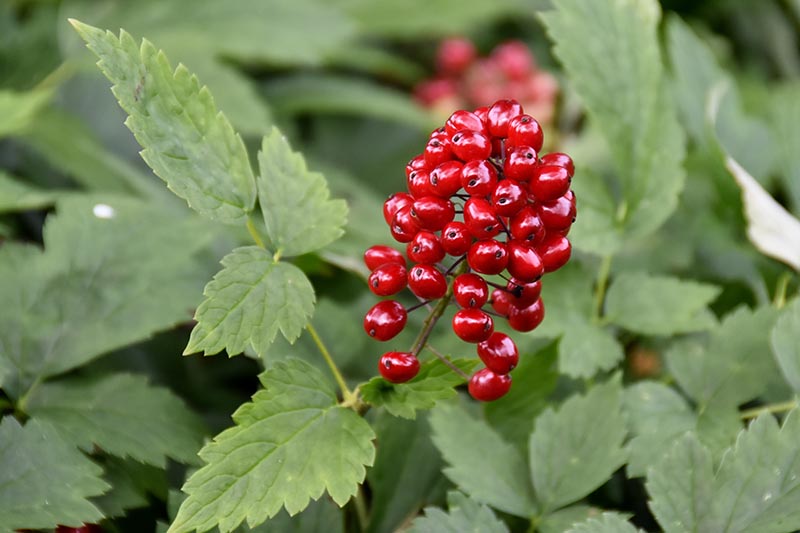
The primary difference between the two is that this species produces red berries instead of white ones, as its name suggests. The fruit also tends to appear a bit earlier in the summer.
Black baneberry (A. racemosa, syn. Cimicifuga racemosa), also known as black cohosh, produces long, fluffy inflorescences and black berries.
You can find A. racemosa seeds available in packets of 50 from Earthbeat Seeds.
Though most varieties of this species also reach a mature height of about two feet, there are some cultivars that grow up to five feet tall, such as ‘Hillside Black Beauty.’
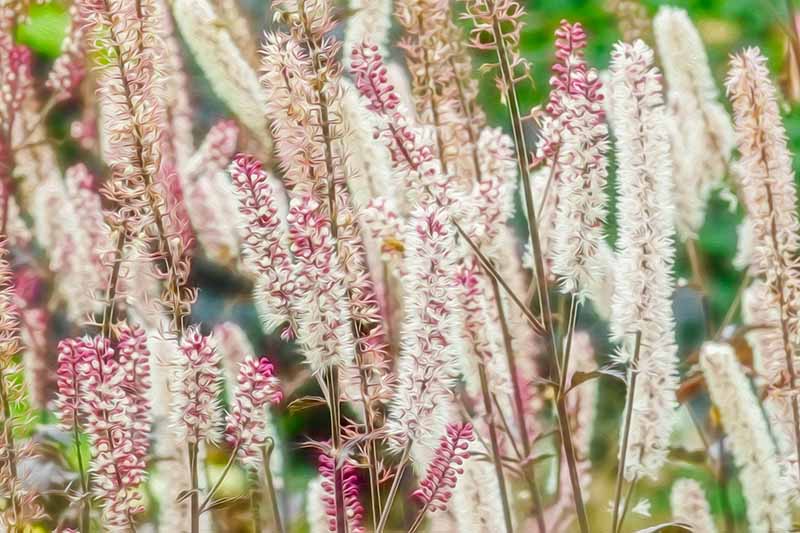
Other popular cultivars include ‘Brunette,’ which features deep purple foliage and fragrant white flowers on black stems in late summer and early fall.

‘Pink Spike’ also features deep purplish-black foliage with pink flowers that contrast with the dark stems.
Managing Pests and Disease
Baneberry is generally pest- and disease-free, if grown in optimal conditions. Deer and rabbits give it a wide berth, and unless other sources of food are scarce it won’t be bothered by mice, squirrels, or voles.
There are some bird species that will eat the fruit, making this a common way that these shrubs extend their distribution.
Insects
Baneberry has very few insect pests to speak of. Occasionally, a sap-sucking insect like an aphid might stop by, but serious infestations are rare.
Aphids are common in the ornamental garden, and while baneberry rarely experiences any long term problems, it is a pest worthy of mention.
A severe aphid infestation can slow the foliar growth of these plants and leave behind sticky honeydew, a substance that attracts ants and that may lead to sooty mold.
If you notice aphids on your plants, simply blast them off with a strong spray from the hose, and apply neem oil or an insecticidal soap according to the manufacturer’s directions.
Disease
As with insects, it is very rare to experience any disease problems with baneberry plants.
Very rarely, baneberries may be affected by rust. A fungal disease caused by Pucciniales species, this is most common in very humid conditions.
It rarely kills plants but may cause red, orange, or white blisters, streaks, or spots to appear on the foliage.
Selecting a shaded location and following proper spacing recommendations can help to prevent this disease. If you notice an infection, you can spray with copper fungicide according to package directions.
You can find Bonide Copper Fungicide available at Arbico Organics.
Best Uses for Baneberry Flowers
Baneberry is easy to grow, although it does so at a glacial pace.
Deer and other small mammals may nibble on it every now and then if there is nothing else to eat, by and large, this plant is left alone by wildlife.
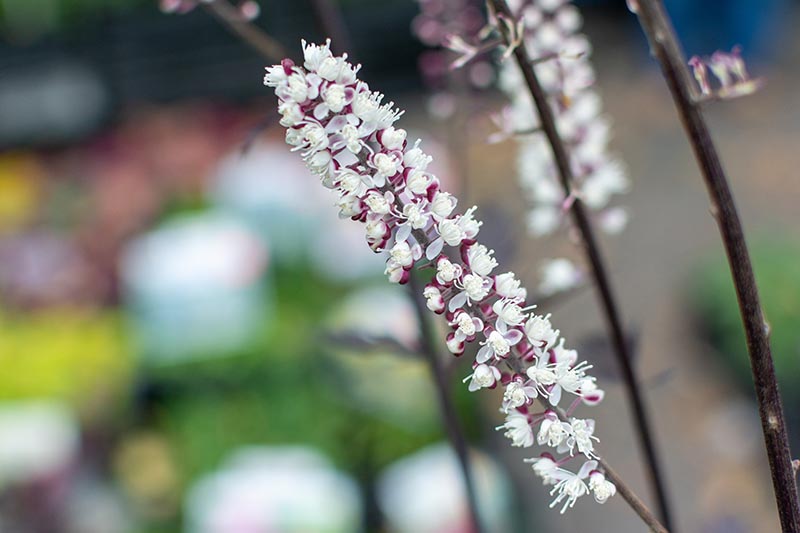
It is also unaffected by juglone, a chemical emitted by black walnut trees and their relatives, so it’s a good option if you’re looking for a specimen to fill in a spot beneath one of these.
Baneberry can be grown as an addition to a woodland garden or a shady border. Its foliage remains vibrant throughout the growing season, and its fruits add interest to the garden long into the fall.
It has a clumping growth habit that makes it a good choice both as a background planting and as a tall ground cover when grown in groups.
Quick Reference Growing Guide
| Plant Type: | Ornamental shrub | Flower / Foliage Color: | Pink, white / green, dark purple |
| Native to: | North America, Asia, and Europe | Maintenance: | Low |
| Hardiness (USDA Zone): | 3-8 | Tolerance: | Poor soil, flooding |
| Season: | Spring-fall | Soil Type: | Sandy loam |
| Exposure: | Full shade to part sun | Soil pH: | 5.6-6.5 |
| Time to Maturity: | 2+ years | Soil Drainage: | Well-draining |
| Spacing: | 24 inches | Attracts: | Bees, birds, pollinators |
| Planting Depth: | 1/4 inch (seeds) | Companion Planting: | Wild ginger, tall ferns |
| Height: | 18-36 inches | Uses: | Woodland planting, shade garden |
| Spread: | 12-15 inches | Family: | Ranunculaceae |
| Water Needs: | Moderate | Genus: | Actaea |
| Common Pests: | Aphids; rust | Species: | Pachypoda, racemosa, rubra |
The Berries Might Be Toxic, But Don’t Let That Keep You Away!
Low maintenance and slow to spread, baneberry shrubs are a good choice for classic woodland gardens.
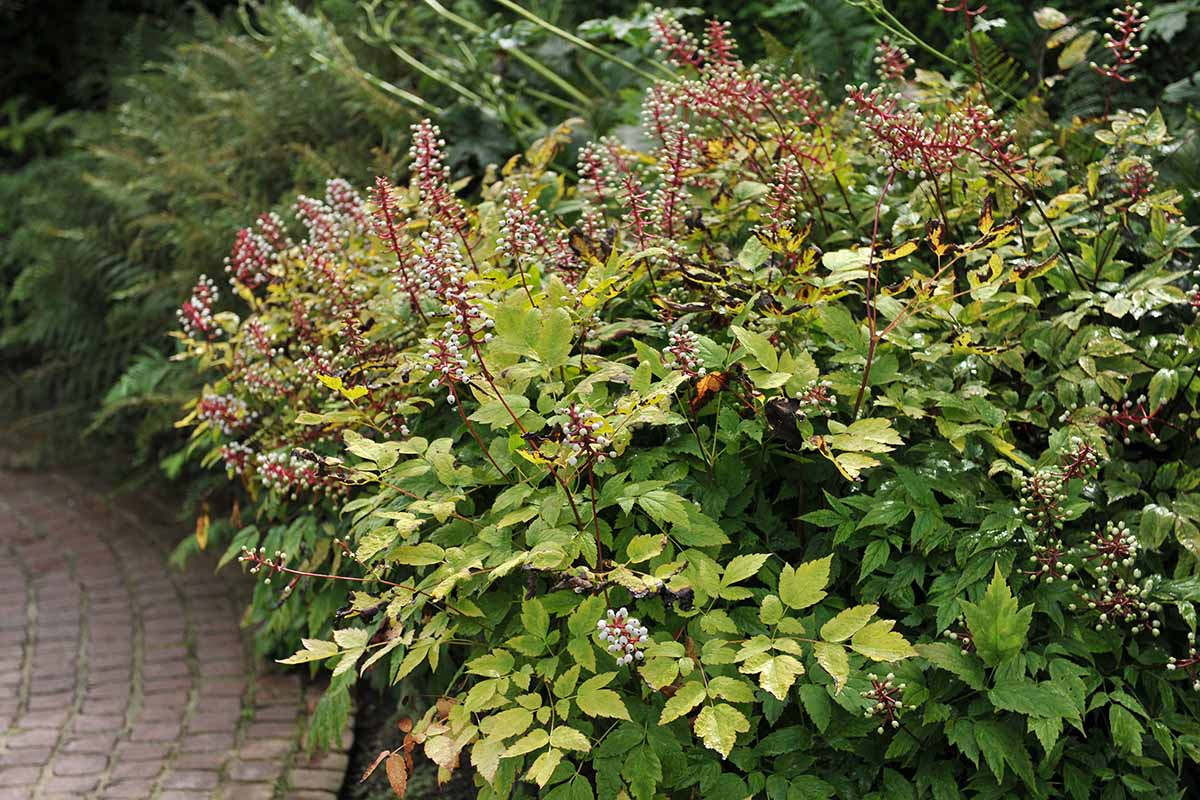
As long as you have the appropriate environmental conditions, baneberry is a low-maintenance addition to US gardens in Zones 3 through 8. Just keep in mind that all parts of the plant are toxic and should not be ingested.
Are you growing baneberry in your garden? Let us know in the comments section below!
Looking for even more ornamental shrubs to add to your landscape? If you found these tips helpful, you’ll find plenty more to read here:
